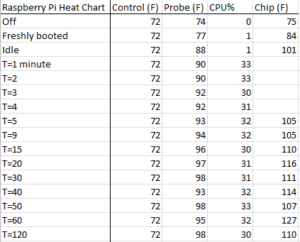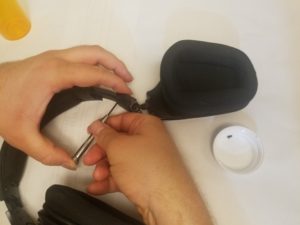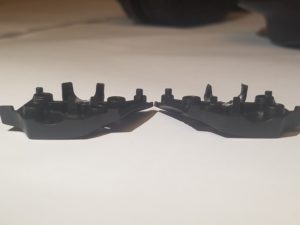Good Morning from my Robotics Lab! This is Shadow_8472, and today, I am covering the repair of my laptop with what I believed (until just minutes ago) was the only full sized SD card reader in the house. Let’s get started.
My overall project will rely on the 3D printer, but the only installation of my printer’s slicer is on my laptop. I’ve had this machine for almost a decade. Even though it’s an old machine, it can still barely keep up with my relatively relaxed demands from it. The slicer is still well within its capabilities relative to my patience.
A few weeks ago, I want to say a month or so, I was setting my laptop up for streaming our church’s service, but it didn’t like its power chord all of a sudden, so I set Blinky Pie (My Raspberry Pi computer) on the case. Meanwhile, after testing and replacing the old power chord, we compared the power port to known good ones, and a central post was missing.
My father and I ordered the part from an official source, and finally got around to changing it out. Note for future operations: When the part you’re replacing is at the bottom of a tightly packed pile of electronics, check the fit with any external connectors before installation. We were okay this time.
The repair took a while. My father did most of the work while I navigated the service manual and kept most of the parts straight as they came off. While it was open, we took the opportunity to extract this impressively rectangular dust bunny from the fan as well as a few rattling pieces, mostly broken bits of plastic, but there was a mysterious screw. During reassembly, I found that three of the screw guides/spacers were broken off from the case. I removed the speaker assemblies from around their spots, and found patterns on the sides to tell which was which. We super glued them in place and finished reassembling. I think at least one of the super glue jobs didn’t hold
We plugged it back in, and… got the same error that started the mess. The brand new power chord isn’t recognized. Some research online suggested it may be the motherboard going bad. That one hurts. I’ve had this machine for a large chunk of my life now, and I still had more plans for it. There may still be a little hope. The internal chord for the replacement power port was a bit longer than the original, so we might have ended up with an imitation or one meant for a different model. Otherwise, it might be a BIOS problem. Time may yet tell.
Final Question: What was the most intense repair you’ve taken part in?





 I’ve had this set of headphones for a while now, and I’m not always the most careful with my technology. I often leave them on top of my cluttered desk or computer tower, and the household cats often pilgrimage to the window behind my desk. Be it from my cat or my klutz, the headphones often would wind up falling to the floor, and I would count my blessing when they still worked each time they tumbled.
I’ve had this set of headphones for a while now, and I’m not always the most careful with my technology. I often leave them on top of my cluttered desk or computer tower, and the household cats often pilgrimage to the window behind my desk. Be it from my cat or my klutz, the headphones often would wind up falling to the floor, and I would count my blessing when they still worked each time they tumbled. I started by removing the four… three of the screws holding what was left of the wayward side together. The forth one was a little stubborn, but it eventually came out. The piece itself had a little more resistance, so my father and I coaxed it out gently.
I started by removing the four… three of the screws holding what was left of the wayward side together. The forth one was a little stubborn, but it eventually came out. The piece itself had a little more resistance, so my father and I coaxed it out gently.  Exploring the inside was a little disappointing. The first sign this wouldn’t be a successful mission was the tweaked, plastic fingers meant to hold onto a grooved peg (helpful for) earpiece rotation. Additional bad news came when I spotted an actual crack in one of the brackets.
Exploring the inside was a little disappointing. The first sign this wouldn’t be a successful mission was the tweaked, plastic fingers meant to hold onto a grooved peg (helpful for) earpiece rotation. Additional bad news came when I spotted an actual crack in one of the brackets. For the purposes of the blog, I decided to pull the other piece off for comparison. Remember all those drops? The teeth on the “good” removed piece were well on their way to deforming in the exact same way. The backpack getting crushed must have affected only the one side and was either enough to finish the job or do it from scratch.
For the purposes of the blog, I decided to pull the other piece off for comparison. Remember all those drops? The teeth on the “good” removed piece were well on their way to deforming in the exact same way. The backpack getting crushed must have affected only the one side and was either enough to finish the job or do it from scratch.